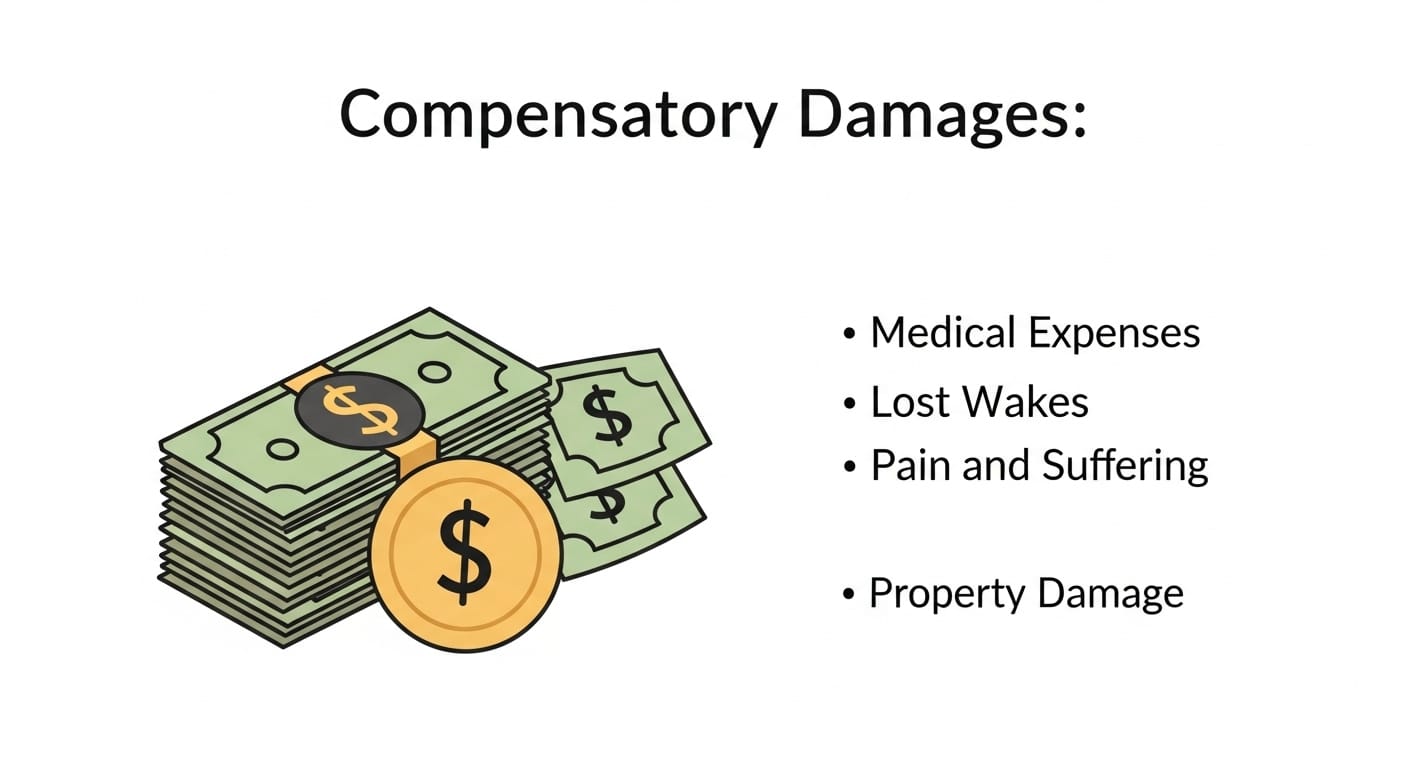Please Note: This post may contain affiliate links. If you click one of them, we may receive a commission at no extra cost to you. As an Amazon Associate, I earn from qualifying purchases.
When it comes to lawsuits, understanding damages is as crucial as knowing the difference between a lawsuit and a lawnmower (hint: one will ruin your day if you get too close).
Damages are basically the money awarded to a person who has suffered loss or injury due to someone else’s actions. But wait! Before you start imagining yourself rolling in cash like Scrooge McDuck, let’s break down what damages really are and how they’re calculated.

Top Takeaways and Key Concepts
Know the Types of Damages: Understand compensatory (actual losses) and punitive (punishment for wrongdoing) damages.
Document Everything: Keep detailed records of medical bills, lost wages, repairs, and related expenses.
Calculate Special and General Damages: Total quantifiable losses first, then estimate non-monetary impacts like pain and suffering.
Factor in Future Losses: Include long-term impacts on earning potential, ongoing care, or lifestyle changes.
Avoid Common Mistakes: Don’t underestimate claims, delay action, ignore emotional impact, or accept initial insurance offers.
Summary of This Article
The article explains the importance of understanding damages in lawsuits, highlighting compensatory and punitive damages as key types. Compensatory damages cover tangible and intangible losses, while punitive damages punish egregious behavior. Calculating damages requires documenting expenses, estimating non-monetary impacts, considering future losses, and consulting experts when needed. It also emphasizes dealing carefully with insurance companies and avoiding common mistakes such as underestimating claims, delaying action, or ignoring emotional impacts. Proper understanding and thorough documentation ensure fair compensation after accidents or other losses.
What Are Damages?

In legal terms, damages refer to the compensation that a court orders one party to pay another for losses incurred. Think of it as a way for the law to say, “Oops! You messed up, and now you owe.” This can cover everything from medical bills after an accident to lost wages because you couldn’t work due to someone else’s negligence.
Interestingly enough, there are different types of damages—like flavors at an ice cream shop. You might prefer chocolate fudge brownie (punitive damages), while your friend goes for plain vanilla (compensatory damages). So, let’s explore these different varieties so you know exactly what you’re asking for when you file that lawsuit!
Compensatory Damages

Compensatory damages are essentially meant to make you whole again after suffering harm. They cover actual losses incurred due to someone else’s wrongdoing. Imagine this scenario: You slip on a banana peel at a grocery store (it happens more often than you’d think) and end up with a sprained ankle.
Compensatory damages would include your medical expenses, any lost wages from missing work, and maybe even pain and suffering—if you can convince the jury that your life is now just one big sad trombone sound.
These damages fall into two main categories: special damages and general damages. Special damages refer specifically to quantifiable monetary losses like medical bills or repair costs—basically anything with an invoice attached.
General damages, on the other hand, cover non-monetary aspects like emotional distress or loss of enjoyment in life (goodbye hiking trips!).
Punitive Damages
Now we arrive at punitive damages—the spicy jalapeño peppers of the damage world! These aren’t about compensating you; instead, they’re designed to punish the wrongdoer for particularly egregious behavior.
Picture this: A company knowingly sells defective products that injure people but keeps doing it anyway because profits matter more than safety. In such cases, punitive damages serve as both punishment and deterrence against future misconduct.
But don’t get too excited about these; they’re not awarded in every case. Courts typically reserve them for situations involving gross negligence or intentional wrongdoing—like when someone steals your lunch from the office fridge (just kidding… sort of).
How Are Damages Calculated?
Calculating how much money you’re entitled to can feel like trying to solve a Rubik’s cube blindfolded—confusing! The process involves several steps:
1. Document Everything: Keep records of all related expenses—medical bills, car repairs, missed workdays—you name it! If it’s connected to your injury or loss, document it.
2. Calculate Special Damages: Add up all those hard numbers first; this includes direct financial losses from things like medical treatment or property damage.
3. Estimate General Damages: This part gets trickier since it’s less tangible. Some people use multipliers based on special damage amounts—for example, if special damages total $10,000, some might argue general ones could be worth double that due to pain and suffering.
4. Consider Future Losses: If your injuries affect long-term earning potential or require ongoing care, factor those estimates into your calculations too.
5. Consult Experts: Sometimes hiring professionals like forensic accountants can help strengthen your claim by providing expert testimony about financial impacts.
The Role of Insurance Companies
Let’s face it; insurance companies often play their own game when it comes time for payouts—think Monopoly but with fewer rubber ducks involved. They’ll usually try every trick in their book (and I’m talking about those thick textbooks) to minimize what they have to pay out in claims.
So, when dealing with them post-accident or injury-related incident? Be prepared! Document everything thoroughly before communicating with insurers because once words leave your mouth—or fingers typing—they can’t be taken back!
Common Mistakes When Claiming Damages
Now that we’ve covered what types exist and how they’re calculated let’s chat briefly about common pitfalls people fall into during this process:
1. Underestimating Your Claims: Don’t sell yourself short! Make sure all aspects of loss are accounted for.
2. Delaying Action: Time limits known as statutes of limitations apply; waiting too long could mean losing out entirely!
3. Ignoring Emotional Impact: Emotional distress counts too! Don’t forget how an incident affected mental health along with physical injuries.
4. Not Seeking Legal Help: Navigating through these waters alone can lead straight into shark-infested territory—consider hiring an attorney specializing in personal injury claims!
5. Accepting Initial Offers Too Quickly: Insurance companies may offer quick settlements hoping you’ll bite without fully understanding potential long-term impacts.
Conclusion
Understanding different types of damages isn’t just legal jargon—it’s essential knowledge that empowers individuals seeking justice after experiencing harm due solely due negligence by others!
Knowing what constitutes compensatory versus punitive—and how best calculate them—is key when pursuing maximum compensation following unfortunate events such accidents or breaches contracts!
By keeping detailed records throughout this journey while avoiding common mistakes mentioned above? You’ll set yourself up nicely toward achieving fair resolution without getting caught off guard along way!
Suggested Resources:
Understanding Personal Injury Claims
https://www.nolo.com/legal-encyclopedia/understanding-personal-injury-claims.html
Calculating Damages After an Accident
https://www.findlaw.com/injury/accident-injuries/calculating-damages-after-an-accident.html
What Are Punitive Damages?
https://www.hg.org/legal-articles/what-are-punitive-damages-31355
Frequently Asked Questions
What are damages in a legal case?
Damages are financial compensation awarded to a person who has suffered harm or loss due to another party’s actions, covering both monetary and non-monetary impacts.
What are the main types of damages?
The two main types are compensatory damages, which reimburse losses, and punitive damages, which punish intentional or reckless wrongdoing.
What is the difference between special and general damages?
Special damages are quantifiable losses like medical bills or lost wages, while general damages address non-economic factors such as pain, suffering, or emotional distress.
When are punitive damages awarded?
Punitive damages are awarded in cases of extreme negligence or intentional harm to punish the wrongdoer and deter similar future conduct.
How are damages calculated in a lawsuit?
Damages are calculated by adding documented financial losses, estimating non-economic impacts, factoring in future expenses, and consulting professionals when necessary.
Can future losses be included in a damages claim?
Yes, future losses such as reduced earning potential, ongoing medical care, or lasting emotional effects can be included in a damages claim calculation.
What are common mistakes to avoid when claiming damages?
Avoid underestimating losses, delaying legal action, ignoring emotional distress, or accepting early insurance offers without full evaluation of long-term impacts.

Kevin Collier is a legal expert passionate about simplifying complex legal concepts for everyday individuals. With a focus on providing clear, practical information, he covers a wide range of topics, including rights, responsibilities, and legal procedures. Kevin aims to empower readers with the knowledge they need to navigate the legal landscape confidently, ensuring they can make informed decisions regarding their legal matters. Through insightful articles and easy-to-understand resources, he helps demystify the law, making it accessible to all.










